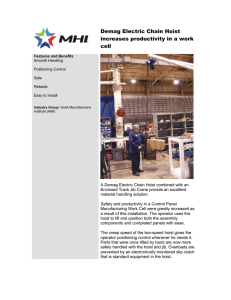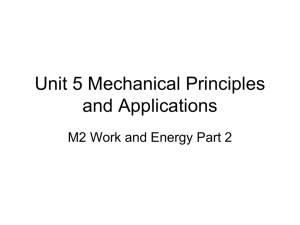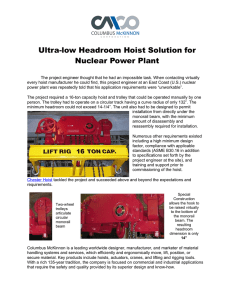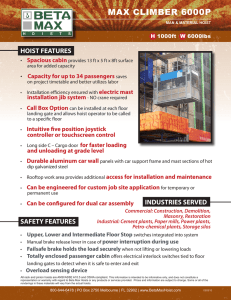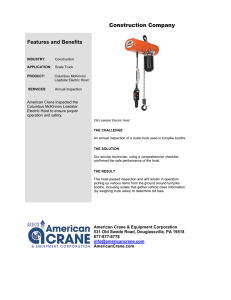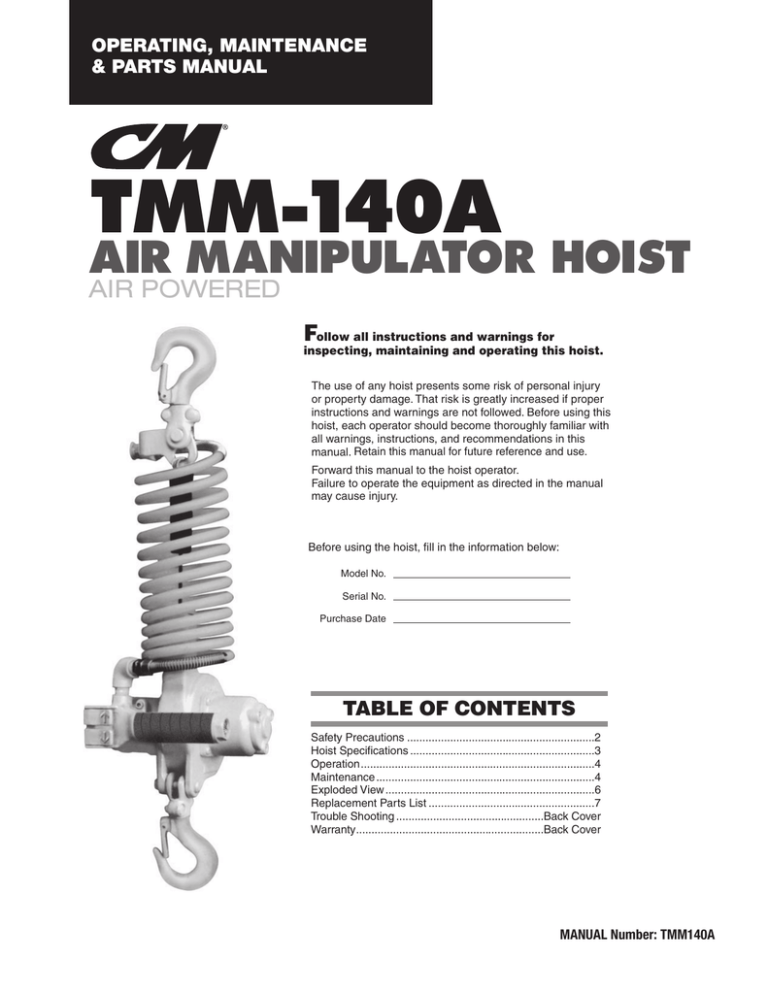
OPERATING, MAINTENANCE
& PARTS MANUAL
TMM-140A
AIR MANIPULATOR HOIST
AIR POWERED
F
ollow all instructions and warnings for
inspecting, maintaining and operating this hoist.
The use of any hoist presents some risk of personal injury
or property damage. That risk is greatly increased if proper
instructions and warnings are not followed. Before using this
hoist, each operator should become thoroughly familiar with
all warnings, instructions, and recommendations in this
manual. Retain this manual for future reference and use.
Forward this manual to the hoist operator.
Failure to operate the equipment as directed in the manual
may cause injury.
Before using the hoist, fill in the information below:
Model No.
Serial No.
Purchase Date
TABLE OF CONTENTS
Safety Precautions .............................................................2
Hoist Specifications ............................................................3
Operation............................................................................4
Maintenance .......................................................................4
Exploded View ....................................................................6
Replacement Parts List ......................................................7
Trouble Shooting ................................................Back Cover
Warranty.............................................................Back Cover
MANUAL Number: TMM140A
16. NOT apply load if bearing prevents equal loading on all load
supporting ropes.
SAFETY PRECAUTIONS
17. NOT operate beyond the limits of the load wire rope travel.
18. NOT leave load supported by the hoist unattended unless
specific precautions have been taken.
Each TMM-140A Air Manipulator Hoist is built in accordance with the
specifications contained herein and at the time of manufacture
complies with our interpretation of applicable sections of American
Society of Mechanical Engineers Code *(ASME) B30.16 “Overhead
Hoists,” the National Electrical Code (ANSI/NFPA 70) and the
Occupational Safety and Health Act (OSHA). Since OSHA states the
National Electrical Code applies to all electric hoists, installers are
required to provide current overload protection and grounding on the
branch circuit section in keeping with the code. Check each
installation for compliance with the application, operation and
maintenance sections of these articles.
The safety laws for elevators and for dumbwaiters specify construction
details that are not incorporated in our industrial hoists. For such
applications, refer to the requirements of applicable state and local
codes, and the American National Safety Code for elevators,
dumbwaiters, escalators and moving walks *(ASME A17.1). We
recommend the use of equipment that meets state and national safety
codes for such use. We cannot be responsible for applications other
than those for which the equipment is recommended.
*Copies of this Standard can be obtained from ASME Order
Department, 22 Law Drive, Box 2300, Fairfield, NJ 07007-2300, U.S.A.
19. NOT allow the load wire rope or hook to be used as an electrical
or welding ground.
20. NOT allow the load wire rope or hook to be touched by a live
welding electrode.
21. NOT remove or obscure the warnings on the hoist.
22. NOT operate a hoist on which the safety placards or decals are
missing or illegible.
23. NOT operate a hoist unless it has been securely attached to a
suitable support.
24. NOT operate a hoist unless load slings or other approved single
attachments are properly sized and seated in the hook saddle.
25. Take up slack carefully - make sure load is balanced and load
holding action is secure before continuing.
26. Shut down a hoist that malfunctions or performs unusually and
report such malfunction.
27. Warn personnel of an approaching load.
Improper operation of a hoist can create a potentially
hazardous situation which, if not avoided, could
result in death or serious injury. To avoid such a
potentially hazardous situation, the operator shall:
Improper operation of a hoist can create a potentially
hazardous situation which, if not avoided, could
result in minor or moderate injury. To avoid such a
potentially hazardous situation, the operator shall:
1. NOT operate a damaged, malfunctioning or unusually
performing hoist.
1. Maintain firm footing or be otherwise secured when operating
the hoist.
2. NOT operate the hoist until you have thoroughly read and
understood the manufacturer’s Operating and Maintenance
Instructions or Manuals.
2. Check brake function by tensioning the hoist prior to each
lift operation.
3. Use hook latches. Latches are to retain slings, chains, etc. under
slack conditions only.
3. NOT operate a hoist which has been modified without the
manufacturer’s approval or without certification that it is in
conformity with ANSI/AMSE B30 volumes.
4. Make sure the hook latches are closed and not supporting any
parts of the load.
4. NOT lift more than rated load for the hoist.
5. Make sure the load is free to move and will clear all obstructions.
5. NOT use hoist with twisted, kinked, broken strands, damaged,
or worn wire rope.
6. Avoid swinging the load or hook.
7. Make sure hook travel is in the same direction as shown on
the controls.
6. NOT use the hoist to lift, support, or transport people.
7. NOT lift loads over people.
8. Inspect the hoist regularly, replace damaged or worn parts, and
keep appropriate records of maintenance.
8. NOT operate a hoist unless all persons are and remain clear of
the supported load.
9. Use the hoist manufacturer’s recommended parts when repairing
the unit.
9. NOT operate unless load is centered under hoist.
10. NOT attempt to lengthen the load wire rope or repair damaged
load wire rope.
10. Lubricate load wire rope per hoist manufacturer’s recommendations.
11. Protect the hoist’s load wire rope from weld splatter or other
damaging contaminants.
12. NOT use end travel stops as routine operating stops unless
allowed by manufacturer. They are emergency devices only.
11. NOT use the hoist load limiting or warning device to measure load.
12. NOT operate hoist when it is restricted from forming a straight
line from hook to hook in the direction of loading.
13. NOT allow your attention to be diverted from operating
the hoist.
13. NOT use load wire rope as a sling, or wrap wire rope around
load.
14. NOT allow the hoist to be subjected to sharp contact with other
hoists, structures, or objects through misuse.
14. NOT apply the load to the tip of the hook or to the hook latch.
15. NOT adjust or repair the hoist unless qualified to perform such
adjustments or repairs.
15. NOT apply load unless load wire rope is properly seated in its
groove.
2
HOIST SPECIFICATIONS
MIN (572.8) 22.55"
TMM-140A Air Manipulator Hoists are rugged units, yet compact
and lightweight. They are designed primarily for work station
applications and are capable of lifting loads up to 300 lbs (140
kg). Precise and infinite speed control allows smooth and
accurate load spotting. The handle mounted pendant control
permits the operator to have one hand free for easily guiding
the load. The disc braking system provides positive load control.
Additional features include rotary vane motor, top and bottom
swivel hooks, and self-storing, corrosion-resistant lifting cable.
TMM-140A hoists are designed and tested in accordance with
our interpretation of the applicable sections of the American
Standard of Mechanical Engineers Code B30.16, “Safety
Standard for Overhead Hoists.”
(36)
ø 1.42"
(15) .59"
(29)
1.14"
To safeguard against the possibility of personal injury
or property damage, follow the recommendations and
instructions of this manual. This manual contains
important information for the correct installation,
operation and maintenance of this equipment. All
persons involved in the installation, operation and
maintenance of this equipment should be thoroughly
familiar with the contents of this manual. Keep this
manual for reference and further use.
(114) 4.49"
(93.4) 3.68"
(207.4) 8.17"
(116) 4.57"
(108) 4.25"
(224) 8.82"
Figure 1 - Hoist Specifications
NOTE: Dimensions in parentheses are in millimeters; other
dimensions are in inches. Top and bottom hook dimensions
are the same.
HOIST DIMENSIONS
Below is a list of basic dimensions of the TMM-140A series
hoist. Refer to Figure 1 for additional information.
GENERAL SAFETY INFORMATION
Model Number
Hoist Capacity (lbs)
Hoist Capacity (kg)
Standard Lift
Lifting Speeds: (fpm)
Full Load (up)
Full Load (down)
No Load (up)
No Load (down)
Air Consumption:
m3/min
CFM
Maximum Air Pressure (psi
Minimum Air Pressure (psi)
Headroom (in)
Housing Dimensions (in):
Depth
Width
Length
Net Weight (lbs)
b.
c.
a.
TMM-140A
300
140
6' 6"
36
59
49
39
d.
0.6
21.2
95
60
229/16
e.
f.
83/16
87/8
233/4
18.7
g.
The load limit for the air manipulator hoist is 300 lbs
(140 kg).
Do not extend the cable more than 6½ ft (2m).
Precautions in mounting:
1. Suspend in secure spot using the top hook.
2. Select a safe and rigid area for hanging.
3. Hang directly above the load to be lifted. Inclined
lifting exceeding an angle of more than 30 degrees
should be avoided.
4. Make sure all supporting structures and attaching
devices are strong enough to hold intended loads.
The installation area must provide safe operating
conditions for the operator including sufficient room for the
operator and other personnel to stand clear of the load at
all times.
To avoid personal injury, always wear approved eye
protection and gloves.
When the machine is idle for a long time, suspend where
moisture is minimal, and do not expose the machine to
rain or dew.
Use only OEM replacement parts when repairing unit.
FOR SAFE OPERATION OF AIR MANIPULATOR
HOIST: DO NOT
a.
b.
c.
d.
e.
f.
To prevent personal injury, do not use the equipment
shown in this manual to lift, support, or otherwise
transport people, or to suspend unattended loads
over people.
3
Lift more than 300 lbs (140 kg).
Operate the hoist when load is not centered under hoist.
Operate the hoist with twisted, kinked, or damaged cable.
Operate damaged or malfunctioning hoist.
Lift people or loads over people.
Exceed the maximum rated air pressure.
g.
h.
i.
j.
Air supply is an important factor for usage of an air
manipulator. These recommended procedures should be
followed so that maximum efficiency can be obtained. To
maintain proper air pressure, it is recommended to use an air
filter, regulator, and lubricator.
Extend the lifting cable beyond red marking.
Operate if the hook travel does not agree with the control
direction.
Operate the hoist in a horizontal or inverted position.
Operate the hoist with slack cable. The weight of the hoist
is required for correct winding of cable or drum.
DO READ
MAINTENANCE
a.
b.
VANE WEAR
Operating and maintenance instructions.
ASME B30.16 Safety Standard for Overhead Hoists.
Excessive wear on the motor vanes or cylinder wall can cause
poor performance. In such a case, the vane must be replaced.
OPERATION
VANE INSPECTION
Like all air tools and hoists, the air manipulator should be used
with clean dry compressed air within the recommended air
pressure ranges. A 3/8" NPT hose attachment is required.
Refer to Figure 2 and Table 1.
1.
2.
3.
RECOMMENDED AIR HOSE
The air manipulator requires a supply hose with a minimum
inside diameter of 3/8" (9.5 mm). If the supply hose is longer
than 33' (10 m), it is recommended to increase the hose
diameter by one size.
Remove the brake case cover (See Ref. No. 50).
Remove the brake cover components (See Figure 2).
Remove the plate (See Ref. No. 43). This will provide
access to vanes.
Table 1 - Vane
Type
Dimension
A
Dimension
B
AIR COMPRESSOR
TMM140A
The air manipulator may be operated with a standard 5 HP
compressor. Drain air daily. Leaving the tank undrained might
result in damage of the unit.
.54"
13.8 mm
1.18"
30 mm
Wear
Limit
.43"
10.9 mm
1.17"
29.7 mm
Standard Size (in/mm)
RECOMMENDED AIR PRESSURE
HOOKS
Use the hoist with an air pressure of 70-95 psi. Operating the
air manipulator with a higher pressure for an extended period
will shorten the unit life and possibly create safety hazards.
See Table 2.
Inspect hooks once daily for cracking, extreme wear, or
spreading. Replace hooks showing any of these signs. If throat
openings are spread wider than maximum permissible increase
listed here, the hooks have been overstressed and must be
replaced. Refer to Replacement Parts List and Figure 2.
DRAIN LINE AND HOSE
Even after draining air from compressor tank, some moisture
might remain in the plumbing and hose. Therefore, release air
momentarily from the air hose before mounting unit to the hose.
Table 2 - Displacement of Hook
AUTO-STOP VALVE
An auto-stop valve is equipped in this hoist. When the “Down”
button is pushed and the hoist lowers to its full extent, the autostop valve will activate, stopping the hoist from lowering any
further. In order to deactivate the auto-stop valve, push the
“Up” button.
Opening A (in/mm)
Std.
Size
If the hoist moves in the up direction when the down button is
pushed, immediately advise your dealer or distributor. Using
the auto-stop valve frequently to stop the hoist in the
downward direction may lead to damage of the hoist and
should be avoided.
1.14"
29 mm
Thickness B (in/mm)
Allowable
Limit
Std. Size
w/ Latch
Std.
Size
Allowable
Limit
+.02"
0.5 mm
.93"
23.5 mm
.59"
15 mm
.55"
14 mm
BRAKE ADJUSTMENT
The brake is self-adjusting and requires little maintenance.
If the brake does not hold the load, follow the directions under
Brake Inspection.
CHECK FOR MOISTURE AND DIRTY AIR
A moist air supply can wash away lubricants on functioning
parts in the unit. Interior grit development will affect
performance of the unit by seeping into closely fitted parts. Use
of an air filter, regulator, and lubricator is recommended.
BRAKE INSPECTION
See Figure 2.
1. Remove the brake case cover (See Ref. No. 50).
2. Inspect the brake spring (See Ref. No. 49) for deformation.
Replace if necessary.
3. Inspect the brake wheel (See Ref. No. 46) for excessive
wear. Replace if necessary.
AIR LEAKAGE
Often times, loss of power is due to leakage of air from hose
connections. Check connections to make sure there are
no leaks.
4
CABLE
HANDLE ADJUSTMENT PROCEDURE
(LEFT HANDED OPERATION)
Replace cable if inspection reveals any broken strands, rust,
deterioration, cuts, deformation, severe bends, kinks, or if the
diameter of the cable becomes less than .146" (3.72 mm).
Note that the original cable diameter is .157" (4 mm).
The TMM-140A Air Hoist is built to operate with a right handed
operator, however the hoists’ handle is interchangeable. Follow
these directions to change the handle to fit the operators needs.
1.
CABLE REPLACEMENT
See Figure 2.
2.
1. Disconnect and remove the coiled air hose and bottom
hook.
2. Remove the four hex head screws and the control handle
assembly.
3. Remove the four hex head screws from the motor case
and open the case.
4. Remove the four hex head screws from the gear case, turn
the hoist so that the cable wheel is facing up and press the
load gear shaft (#65) through the cable wheel.
5. Remove the cable wheel assembly and the hex head bolts
in the motor side wheel.
6. Remove the set-screw (#85C) from the gear side wheel
and remove the wheel shaft.
7. Unwind and remove the old cable, Note retain the brass
colored knock pin.
8. Insert the new cable though the top of the housing, slide
the knock pin onto the cable and insert the cable into the
gear side wheel.
9. Rap the cable twice inside the gear side wheel and insert
the cable end into the notched area.
10. Reinstall the wheel shaft so that the notch for the setscrew is correctly oriented, this will align the bolt-holes and
tighten the set-screw.
11. Reinstall the knock pin into the oval grove in the gear side
wheel with the long tip up.
12. Reinstall the motor side wheel, insert the knock pin tip
through the oval grove, orient the spring pin (#74) correctly
so the bolt-holes are aligned.
13. Reinstall the four hex head screws and reinstall the cable
wheel assembly with the knock pin facing up.
14. Insert key (#76) into slot in the cable wheel assembly,
insert the load gear assembly through the cable wheel and
reinstall the gear cover screws.
15. Align the drive pinion (#54) so that it correctly fits into the
motor shaft, reinstall the motor housing and four screws.
16. Reinstall the control handle assembly and four screws and
reattach the bottom hook.
17. Remove top hook and air inlet from the old cable
assemble and reinstall on the hook plate of the new cable
assembly and reinstall coiled air hose.
3.
4.
5.
6.
7.
Remove the hoist from its hanging position and disconnect
the air supply. Push the operating buttons to confirm that
the hoist does not operate.
Remove the M5 x 14 hex screws which hold the handle in
place. Make sure the springs do not spring from under the
handle when the hex screws are removed.
Remove the hose nipple from the top of the handle and
plug (3/8 - 18) from the bottom of the handle.
Reassemble the hose nipple and hex taper plug (3/8 - 18)
as instructed in section 3 above. Assemble the handle
onto the hoist.
Assemble the 4 hex screws (M5 x 14) in section 2 into the
handle and onto the hoist. At this time, make sure the
valves close properly.
Apply air to the hoist and check for air leakage.
Hang the hoist in position and slowly check the up and
down movement of the hoist.
LUBRICATION
Daily, before using and at the end of each shift, disconnect the
air hose from the air inlet and pour 10 cc’s of recommended oil
(turbine oil 140#) into the air inlet, reconnect and then operate
to fully lubricate the air manipulator.
The line lubricator is recommended to be installed as closely as
possible to required area, preferably between the air pipe and the
hose leading to the unit. This procedure will guarantee a constant
and adequate supply or lubrication to all functioning parts.
A sufficient amount of grease is required in the reduction gear
at all times. The reduction mechanism is formed of a specially
designed differential reduction gear system. It consists of inner
gears with 3-planet gears engaged within a single driving gear.
The reduction ratio for the air manipulator is 1:62. Remove the
gear case cover to inspect for grease.
Keep the cable lubricated with a light oil or commercial wire
rope lubricant. This will enhance the cable life.
Table 3 - Recommended Oil
Maker
Turbin Oil
No. 2140
Esso
Standard
Mobil
Oil
Shell
Oil
Turbin
No. 2
Red Horse
Turbin Oil
No. 2
140
Turbin Oil
Table 4 - Recommended Grease
NOTES: To wind up new cable, hang hoist vertically from the
top hook and attach the airline.Hold TMM-140A so that the
cable is straight and taught. Press the UP button and wind the
cable. Be sure not to press the “DOWN” button, as this will
reverse wind the cable and damage the hoist.
Maker
Grease
If the hoist shows air leakage or does not operate
properly, immediately stop operating the hoist and
stop the air flow to the hoist. Reperform the above
procedure as stated above. If the hoist still does not
operate correctly contact your dealer or distributor.
5
Esso
Standard
Mobil
Oil
Shell
Oil
Beacon
No. 2
Mobilplex
46
RETINAX
CD
Figure 2 - Air Manipulator Hoist
86
87
53
90
92
91
82
1
93
50
51 49
52
37 46
4744
2
48
45
85
58
59
3
43 40
36
38
58C
58B 58B
58A
41
42 79
39
4
5
14
19
35
75
15
12
11
10
11
74
62 61
60
63
61 63C
63B
63A
62
81
80
73
83
77
94
13A
13B
22
28
8
71
72 85C
70
9
6
26
27
29
32
33 34
20
21
24 23
24 25
67
76
30 31
93 92 91
7
82
16
64
90
1718
69
84
68
78
65
6
66
54
55
56
57
Parts
Ref
No.
1*
2*
3*
4*
5*
6
7
8*
9
10
11*
12*
13A
13B
14*
15
16*
17*
18*
19
20
21
22
23
24
25
26
27
28
29
30
31
32
33
34
35*
36*
37*
38*
39*
40*
41
42*
43
44*
45*
46*
47*
48*
49*
50*
51*
52*
53*
54
List for Air Manipulator Hoist
Description
Part
Qty
No.
Air Inlet
420982WAO
1
Air Inlet Lock Nut
420982WBO
1
Coil HC - 9X3.7M
137201006
1
Elbow 3/8"
135101003
1
Round Nipple 3/8"
135004003
1
Throttle Valve Body Assembly 420985ACB
1
Throttle Valve Body Grip
136608140
1
Hex Screw M5 X 14
131905014
4
GDL Plug 3/8NPTF
134903003
1
Throttle Valve
420985AAO
2
O-Ring P-6
131108004
6
Throttle Valve Spring
130802076
2
Throttle Valve Lever A
420985UYO
1
Throttle Valve Lever B
420985UZO
1
Lever Pin 4 X 46
130402030
1
Throttle Body Packing
136102079
1
Muffler
420982BLO
1
3/4" Nipple Screen
136801001
1
Snap Ring H-20
130301020
1
Motor Case
420985BGO
1
Stop Valve Pin
420985850
1
O-Ring S-4
131103002
1
Stop Valve Spring
130802073
1
Stop Valve Pin Bushing
420985780
1
O-Ring S-10
131103008
2
O-Ring S-6
131103004
1
Stop Valve
420985W30
1
O-Ring S-9
131103007
1
O-Ring S-7
131103005
1
O-Ring S-14
131103012
1
Stop Valve Cover Plate
420985980
1
Hex Screw M5 X 10
132805010
3
Washer M12
131309012
1
Cam
420985740
1
Cam Shaft
420985970
1
1
130106004
Bearing 6003ZZ
Rotor
420982BP1
1
Snap Ring S-10
130302010
1
Cylinder
420982BT1
1
Cylinder Knock Pin 4X52.5
130402031
1
Vane
137102013
5
Front Plate
420985170
1
Bearing 6000ZZ
130106001
1
Rear Plate
420985180
1
Bearing 6000
130104001
1
O-Ring S-55
131103041
1
Brake Wheel
420982E1O
1
Brake Wheel Key
130408062
1
Brake Piston
420982EF2
1
Brake Spring (14.6 X 11)
130802105
1
Brake Case
420982KAO
1
O-Ring S-55
131103041
1
Spring Pin 6 X 12
130606012
3
Hex Screw M5 X 14
131905014
4
Drive Pinion
420985GKO
1
Ref
No.
55*
56*
57*
58*
58A*
58B*
58C*
59*
60*
61*
62*
63*
63A*
63B*
63C*
64
65
66*
67*
68
69
70
71
72
73
74
75
76
77
78*
79
80*
81*
82*
83*
84*
85
86*
87*
88*
89*
90*
91*
92*
93*
94
95
Description
Bearing 607
Gear Case Cover
Hex Bolt M5 X 10
Idle Gear Assembly
(Includes items 58A, 58B,
and 58C)
Idle Gear
Needle Bearing Kt-81110
Idle Gear Ring
Idle Gear Shaft
Idle Gear Shaft
Idle Gear Frame Spacer
Bearing 16004
Gear Case Assembly
(Includes items 63A,
63B and 63C)
Gear Case
Internal Gear
Internal Gear Ring
Hex Screw M5 X 14
Load Gear
Needle Bearing TLA-1010
Bearing 6004ZZ
Gear Case Adapter
Hex Bolt M X 14
Gear Side Wheel
Knock Pin
Motor Side Wheel
Wheel Shaft
Spring Pin 6 X 12
Hex Bolt M5 X 14
Gear Side Wheel Key
Wheel Cover
O-Ring S-56
Hex Bolt M5 X 14
Hex Screw M5 X 8
Rope Guide Bushing
Hook Assembly
(Includes items 90, 91
92 and 93)
Under Hook Bolt
U-Nut M8
Upper Hook Plate Assembly
with Wire Rope
Under Hook Shaft
Split Pin 3 X 20
Hose Stem 3/8 X 1/2
Plug 3/8
Hook
Hook Safety Claw
Spring Pin 3 X 24
Spring Ring
Warning Decal
Max Air Pressure Decal
(Not Shown)
* Indicates that these are common parts among the TMM-140 and the TMM-140A Series Hoist.
7
Part
No.
130101007
420982FKO
131705011
420982FLC
Qty
420982FLO
130170012
420982FPO
420982FN1
420982FU1
420982FWO
130116004
420982FJA
1
2
1
2
1
2
2
1
420982FJO
420982GHO
130802103
131905014
420985CLO
130151010
130106005
420985990
131705014
420985WDO
420985L10
420985WEO
420985600
130606012
131705014
130408067
420985WGO
131103042
131705014
132305008
136302027
420982PAB
1
1
1
4
1
1
1
1
4
1
1
1
1
1
4
1
1
1
4
1
2
2
420982QEO
134501008
420985SAC
1
1
1
420601QVO
130703020
134803040
136503003
420982PFO
420620P10
130603024
130802046
687J4
687J5
1
1
1
1
2
2
2
2
1
1
1
1
3
2
TROUBLE SHOOTING
––– Remedy–––
––– Probable Cause –––
Air manipulator does not start
1.
2.
3.
4.
5
6.
Dust or other obstacles in pipe penetrating into rotor.
Control valve not opening.
Vane wear.
Vane not sliding properly in rotor groove due to grease or humidity.
Brake not fully loosened.
Bearing wear on both sides of rotor will cause seizure of rotor and faulty rotation.
1.
2.
3.
4.
5.
6.
Clear air hose.
Check for obstacles or broken valve spring.
Lubricate properly, See Tables 3 and 4.
Clean rotor grooves and inspect vanes per noted instructions.
Inspect brake per noted instructions. Refer to BRAKE ADJUSTMENT, page 6.
Replace worn bearing, refer to Figure 2 for disassembly.
1.
2.
Lubricate properly and sufficiently, See Tables 3 and 4.
Check for sufficient level of grease.
1.
2.
3.
4.
5.
Check air pressure and consumption.
Confirm air hose size.
Check with dealer.
Lubricate properly, See Tables 3 and 4.
Check with dealer.
1.
Have parts replaced by dealer.
High temperature on surface of body
1.
2.
Lubricant oil not sufficient.
Extraordinary wear of gears or bearings.
Poor lifting performance
1.
2.
3.
4.
5
Lack of air pressure.
Hose size too small.
Brake is not opening fully.
Lack of lubrication.
Wearing of vanes.
Air is leaking
1.
Damage to the packing or O-rings.
Disassembly by an Authorized Repair Center may be required for maintenance procedures.
Overloading and Improper Use Can Result In Injury
TO AVOID INJURY:
• Do not exceed working load limit, load rating, or capacity.
• Do not use equipment to lift people or loads over people.
• Use only alloy chain and attachments for overhead lifting.
• Read and follow all instructions.
WARRANTY
Standard Columbus McKinnon Lifetime Warranty against defective workmanship or material applies.
140 John James Audubon Parkway • Amherst, New York 14228-1197
1-800-888-0985 • Fax 716-689-5644 • www.cmworks.com
April 2013
TMM140A
©2013 Columbus McKinnon Corporation. All Rights Reserved.

